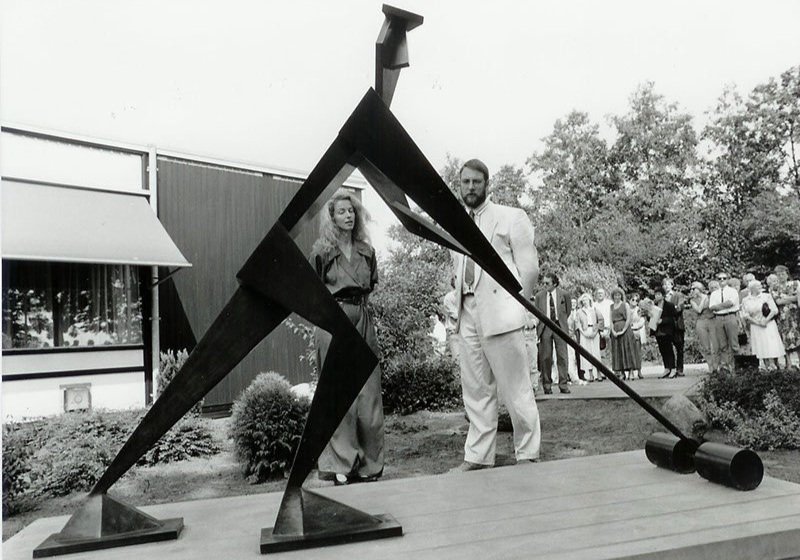Dynamic shapes are characteristic of Ria Groenhof's spatial work. Often the image is initially formed by two movements that intersect. Lines intersect each other, both in the plane and in space. Each time produces a repetition of sharp corners. Also as if the surface is literally broken open in a pattern of splintered shapes. In that respect, the design for a statue in which a door opens and closes is possibly the most typical. Here all financial aspects are summarized in a meaningful whole. The abstraction of a purely geometric interplay of lines suddenly changes into a recognizable representation. Anyone who knows Ria Groenhof's paintings will find this formal language familiar. While in the paintings space is only suggested in a complex layering of intersecting and overlapping color patterns, here it is an actual space that you can really perform. The image seems to have emerged directly from a painting. The third dimension has not been added, rather opened. The reference to a door was not invented, but seems to have arisen naturally.
Conversely, the spatial work sometimes gives the impression of being a “painting in space”. After all, you only see one view. The plastic effect of the statue can only be experienced by walking around it. The views are then joined together into a spatial whole. In a photograph, the similarity in the formal language of image and painting is even stronger. Here the image is captured in that one view. Looking through your eyelashes sometimes shows strange effects. For example, the artwork for Oude- and Nieuwehorne appears to be a fragment that is emphasized directly from a painting. The converging diagonal lines that cross each other in two directions, the sharp angles, the complex pattern, the overlapping shapes. In short: it is the language forms of the surface that make a space surprising.
But it is very much the case. After all, the image literally takes possession of the space, not limited by a confrontation of two geometric patterns, but above all as a concrete combination of recognizable objects: a seating element and five hooked spades. Merger through collaboration is a telling title in this case. Those words seem to be striking not only because of the symbolism of the place where the statue is located: a crossroads where an old and a new village come together. It is also a meeting of two visual languages. One takes place on the plane, the other in space. It is precisely because of their merger that they work together, creating an exciting whole.
The play in the border area between figuration and abstraction has many variants. Sometimes the recognizable shape has almost completely disappeared, as in the sheet steel design for De Wachters. Sometimes it is prominently present, such as in the bronze Peat Cutter in Tjalleberd. But in both cases the language has the same grammar. It is again and again a basic structure of prismatic surfaces and sharp angles in which the image is made. It is difficult to achieve this figuration by reducing the recognizable form to a schematic abbreviation, or the other way around: by building it up from a number of partial basic elements.
The paintings have been the underground laboratory in which this formal language was developed. In any case, it is an artificial language, not based on the spontaneous imagination of a fleeting observation, but rather on a well-thought-out method of representation and a well-considered construction. It is a process that returns from abstraction to reality and not the other way around. In the distance a memory is evoked of the later work of Thijs Rinsema. He also practically returns from pure abstraction to a schematization of reality in a language of prismatic forms. The anatomy of the compass and ruler expressed in his Footballers is effectively related to Ria Groenhof's Peat Cutter. In addition, they are also associated with the art of the fifties, when the stylized abstraction of organic forms flourished.
Be that as it may, Ria Groenhof's images speak their own language. Not only in the paintings, but also in the spatial work, she is apparently looking for a new synthesis. In that search she seems to find something new. Tried-and-tested visual languages are combined, again and again, until suddenly a new connection between space and plane arises.




